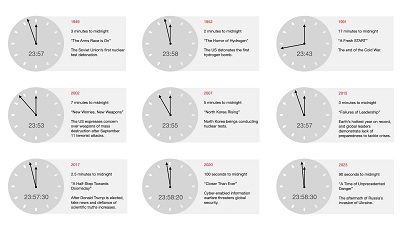The Doomsday Clock Set to 90 Seconds, a symbolic representation of the perceived global existential threats, has recently been set to 90 seconds to midnight by the Bulletin of the Atomic Scientists. This announcement has sparked concerns and curiosity among people worldwide. Let’s delve into the factors leading to this critical decision and its implications for our future.

Understanding the Doomsday Clock
What is the Doomsday Clock?
The Doomsday Clock is a metaphorical timepiece that represents the likelihood of a global catastrophe, specifically a nuclear war or other catastrophic events. It was created in 1947 by the Bulletin of the Atomic Scientists as a visual representation of the world’s proximity to potential disaster. The clock is maintained by a panel of experts called the Science and Security Board, in consultation with the Board of Sponsors, which includes Nobel laureates.
How does the Doomsday Clockwork?
The Doomsday Clock does not measure time in the conventional sense. Instead, it serves as a symbolic representation of the perceived threats to humanity. The time on the clock represents the “minutes to midnight,” where midnight symbolizes a global catastrophe. The closer the clock is to midnight, the greater the perceived danger.
The 90-Second Update
Why is the Doomsday Clock set to 90 seconds?
The recent adjustment of the Doomsday Clock to 90 seconds to midnight reflects the heightened concerns about the world’s safety and security. The decision takes into account various factors, including nuclear weapons, climate change, emerging technologies, and geopolitical tensions. The Bulletin of the Atomic Scientists believes that the world is facing an unprecedented combination of risks that could potentially lead to disastrous consequences.
Nuclear Weapons and Arms Control
One of the primary factors influencing the decision to move the clock closer to midnight is the persistent threat posed by nuclear weapons. The lack of progress in disarmament efforts, the modernization of nuclear arsenals, and the withdrawal from arms control agreements have all contributed to the increased risk of a nuclear conflict.

Climate Change and Environmental Challenges
The impact of climate change on global security has also played a significant role in adjusting the Doomsday Clock. The accelerating pace of climate change, rising sea levels, extreme weather events, and the failure to adequately address environmental challenges pose a substantial threat to human civilization and increase the likelihood of conflicts over resources.
Emerging Technologies and Disinformation
The rapid advancement of emerging technologies, such as artificial intelligence and cyber warfare, presents both opportunities and risks. The potential misuse of these technologies, coupled with the spread of disinformation and the erosion of trust, amplifies the danger of unintended consequences and escalations.
Geopolitical Tensions and International Relations
Geopolitical tensions and strained international relations have further contributed to the heightened risk portrayed by the Doomsday Clock. Conflicts, territorial disputes, and the erosion of diplomatic norms and institutions have created an environment of increased uncertainty and the potential for large-scale conflicts.
Conclusion
The adjustment of the Doomsday Clock to 90 seconds to midnight serves as a sobering reminder of the numerous challenges facing humanity. It highlights the urgent need for concerted global efforts to address nuclear disarmament, climate change, emerging technologies, and geopolitical tensions. By taking collective action and fostering cooperation, we have the power to mitigate these risks and create a safer and more sustainable future for generations to come.

Visit: Sleep Apnea Dental Appliances Market 2023
FAQs
What is the significance of the Doomsday Clock?
The Doomsday Clock symbolizes the world’s proximity to potential global catastrophe, serving as a reminder of the risks and challenges humanity faces.
Who determines the position of the Doomsday Clock?
The Doomsday Clock is determined by the Bulletin of the Atomic Scientists, with guidance from a panel of experts and Nobel laureates.
What are the primary factors influencing the Doomsday Clock setting?
Factors such as nuclear weapons, climate change, emerging technologies, and geopolitical tensions are among the primary influences on the Doomsday Clock.
How can humanity address the risks highlighted by the Doomsday Clock?
Addressing these risks requires global cooperation, including efforts toward nuclear disarmament, climate action, responsible technology development, and diplomatic resolutions to conflicts.
What can individuals do in the face of these global challenges?
Individuals can contribute by raising awareness, supporting organizations working on these issues, and engaging in sustainable practices that mitigate climate change and promote peace.